Interview with ‘Dimanche (Sunday)’ NFBC Director Patrick Doyon
This year has been a particularly strong one for the National Film Board of Canada, with two of its recent films being internationally heralded and earning themselves Oscar nominations. One such film is Patrick Doyon’s “Dimanche”, a traditionally animated mini-masterpiece that strongly evokes both the long-standing traditions of Canadian animation as well as the rural landscape of Quebec as a cultural backdrop.
Coming from a background in design and illustration, Doyon extended his work to the world of animation with his student short “32:11” (2002). Having been brought to the attentions of the NFB as a successful applicant to their annual bursary scheme Hothouse in 2006, Doyon’s first professional NFB film “Dimanche/Sunday” (2011) is a strongly relatable tale of a pivotal day in the life of a young Canadian boy whose perception of the world is suddenly altered forever.
What was your animation background/experience leading up to your eventual involvement with the NFB?
I studied graphic design at the Université du Québec à Montréal and there were two optional animation classes that I took. In these we studied many animation techniques and the professor introduced us to many animated film classics (Amanda Forbis and Wendy Tilby’s “When the Day Breaks,” the Quay brothers’ “Crocodile Street,” Raoul Servais’ “Harpya”). It was there that I realized the narrative potential of animation.
With the encouragement of my professor I submitted “32:11” to a few festivals, including Zagreb and Ottawa. I was lucky enough to be accepted and be present at the screening. It encouraged me to keep going in the field.
After graduation, I immediately got a job as a storyboard assistant on an animated TV series. This was the perfect way to start since for the first time in my life, I had to draw for forty hours a week. In eight months of working, I greatly refined my drawing. Next, I contributed to another TV series by creating short animated clips that were integrated into the main show. A blessing! The producer gave me carte blanche so I had the great chance of being able to develop my own style and get paid for it. You can see a few of those clips on my Vimeo account.
I have long followed the NFB’s work and while I was at university I started to keep an eye out for the producing opportunities it offered. In 2006 I submitted a project for the third edition of Hothouse (currently on its eight installment)… And I was one of five directors chosen!It was then that I made “Square Roots”. The goal of the project, a Michael Fukushima initiative, is to give six young producers the opportunity to create a very short animation clip in a professional setting with tight deadlines. Each installment is overseen by an experienced director, in my case Shira Avni. It was a wonderful learning experience because it was there that I learned the necessary steps for completing a short film.
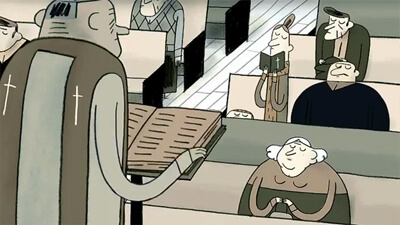
©2011 Patrick Doyon/NFB
Was animation always your ultimate career goal or did you fall into it later on?
No, not at all. Animation came in my life quite late, around the time I was at university. Before that, I read a lot of comics and had always wanted to make my own. Maybe some day I will have the courage to embark on that adventure…
Was it your experience as part of Hothouse that ultimately led to making “Dimanche” with the NFB?
Not necessarily, but my experience with Hothouse taught me to prepare and visualise every step in order to achieve the finished product. It also was at that time that I met Michael Fukushima (co-producer of “Dimanche”, along with Marc Bertrand) and Luigi Allemano, the composer and sound designer I worked with on the film.
Is it rare for a film such as yours to be co-produced by both the English and French divisions of the NFB?
My producers could better answer that question, but to the best of my knowledge, it’s the first co-production between the NFB’s French and English studios. At the very least, it happens very rarely…
Visually the film’s loose traditional style is evocative of several previous NFB directors (such as Cordell Barker/Torill Kove). Have these or others played a role in influencing your style?
I am glad you mention these directors since I really enjoy their work, even though I don’t think I can compare to their talent. They did not directly influence “Dimanche”, though I did love “Strange Invaders” and “The Danish Poet”. Yet it is true when you think about it, their films and mine do have some similarities (paper animation, simplicity in the drawing style, their sense of humour). Perhaps I have watched them so often they are now part of my subconscious. They influence me without my noticing.
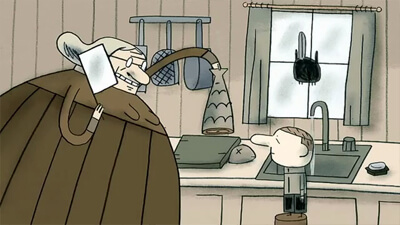
©2011 Patrick Doyon/NFB
Do you have any major artistic or storytelling influences outside of the world of animation?
In film, I love Wes Anderson’s work. His scenes are always the result of an acute attention to detail. Each composition element is carefully set and the colour palette well chosen. Furthermore, he uses old-school special effects (like the aquatic creatures in “The Life Aquatic with Steve Zissou”). The theme of the family and its dysfunctions speaks to me. There is also the director Michel Gondry whose movies “The Science of Sleep” and “Eternal Sunshine of the Spotless Mind” are full of visual treasures.
Yet, as I have mentioned, I read a lot of comic books (especially European) and I generally like everything from the French publishing house L’Association. They are daring books that go beyond the normal boundaries and are written by authors with a very personal vision.
From a filmmaker’s perspective, does the NFB have a more positive attitude toward making films using traditional processes than other studios?
I believe the NFB supports a wide variety of animation techniques, but especially the personal vision of the filmmaker. If he believes that traditional paper animation is the best way for the movie, the producer will give him the necessary resources, It’s the same thing for someone who wish to use pinscreen (Michèle Lemieux) or glass painting (Martine Chartrand).
I’m especially enamoured of the desaturated colour palette that is used in the film. What determined that (eg. was it for tone/mood or purely an aesthetic decision)?
At the beginning of production, that wasn’t at all the palette I was looking for. I wanted a palette of very warm colours (like red, orange and sepia) that reflected the colours of autumn in Québec.
I changed my mind when I realised that the tone (melancholic) of the movie might not suit it well. I then decided on a cold and desaturated palette of greys and blues, which correspond better to the end of an autumn day, when all the leaves have fallen and winter is very close.
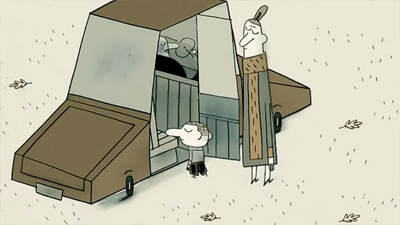
©2011 Patrick Doyon/NFB
Where did the idea for the story come from? Was it one you had in mind already or was it developed with the NFB?
When I first submitted the project in 2007, it had nothing to do with the film you have seen. In fact, I had submitted a storyboard about a dog following his master (!). I had made a short comic about my childhood Sundays in support of the project. But my producers fixed on the comic and suggested that I develop a film project around it.
I wanted to make a film about boredom without boring the viewers. I remember that Sundays could be powerfully boring. So I drew on my childhood memories to weave the story. I changed or exaggerated a lot of things, so my movie is not autobiographical. For example, in my family, there were a lot children and I was never the only child present during that day. But for the purposes of the story, I eliminated a lot of cousins.
The film is peppered with somewhat surreal moments that seem to increase as it goes on, such as the relationship between the boy and the bear. Can you discuss some of the symbolic aspects of the film?
Death, in a naïve sense, is very present in the movie. Whether it is the hare, the fish or the bear, all the animals in the story die. And the crows are never far away to claim the corpse. Without mentioning the plant, which is definitively closed (there’s a “for sale” sign on it.)
I wanted to build the story on two levels: Firstly, to tell the story of a bored boy who escapes through his imagination; Secondly, to paint the picture of a rural region of Québec. Everything surrounding the boy dies and even his imagination’s creation (his relationship with the bear) is killed by the environment. It is the type of day where the child truly understand his surroundings (he looks toward the closed plant at the end of the movie) and becomes a little older than he was at the beginning of the film. Small actions, like putting his cap back on and opening the car door himself, let us guess that he has grown up; Sundays will never be the same again.
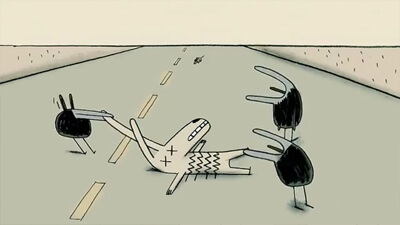
©2011 Patrick Doyon/NFB
What inspired the film’s rural setting?
My entire youth was spent in a tiny village in northern Québec. There were 1,000 inhabitants and only one main road. The railway line passed very near the house, so each time the train passed, the house shook (although not quite as much as in the film). There was also a plant that, as far back as I can remember, had always been closed. I collected all these elements to create the village of the film.
Are the events of the film based on or inspired by your own childhood/family life?
Yes and no. Many of the film’s events were inspired by my childhood memories of boring Sundays: going to mass with my parents and visiting my grandparents were part of the Sunday routine. I have a vague memory of having flattened a coin under a train, but I never would have dared put it in the collection envelope. I did hate the fish prepared by my grandmother and my grandfather did always take a nap during the afternoon (but I never stole money from him! I swear!).
Everything in the movie is a mix of fiction and reality, so it is hard to distinguish between what is true and what isn’t.
I would say two years. It took six months of part time pre-production to establish the scenario, do the storyboard and decide on the design. Then I worked on it full time for 18 months. I did the animation alone (anyway, the way I work is so messy that it would have been difficult for me to delegate) and I had help for colours and compositing (a very good thing, or I’d still be working on it). So it was a really small team.
Midway through production, when my daughter was born, I took a few weeks off. It was perfect timing as I was seriously doubting the film’s quality, and I was about to abandon the production altogether. I sincerely believed it would be the worst movie of all time. Delphine’s birth put things back in perspective for me, and gave me enough serenity to finish the film.
When you’ve produced a film for the NFB how much control over it do they retain? Are you allowed to distribute it and promote as the director or is that all in their hands?
The NFB leaves a lot of creative liberty to creators and that is why it is so strong in the world of animation. Of course, there is always some supervision from the producers, but the final decision often comes from the creator. It’s that vision that prevails and the studio trusts its creators.
As far as distribution and promotion, the studio has its own resources. For “Dimanche”, I never had to file papers or send the movie out to festivals myself. As the NFB produces many animated films every year, the studio would rather keep control of establishing a specific strategy for promotion and distribution. Personally, I would never complain about it, as that is an aspect of the work that can quickly become boring and time consuming. However, it doesn’t keep me from doing some promotion (creating a Facebook page for the film, for example) or from attending showings of the film in different festivals.
Given the film has little by way of dialogue, does the sound/foley/music play more of a role in getting the story across?
Yes, the music and sound design play a crucial role, especially when there is no dialogue. For “Dimanche”, it was Luigi Allemano who brilliantly took charge of these aspects of the film. It wasn’t until he gave me a first draft of the music that I started believing that the film maybe wasn’t so bad after all. He managed to translate the emotion perfectly through his music. The same melody can be heard all thorough the movie, but with a different tempo or played on different instruments…this contributes to the repetitive aspect of boring Sundays. You can hear some of Luigi’s thoughts about the musical track here (8min, 20sec).
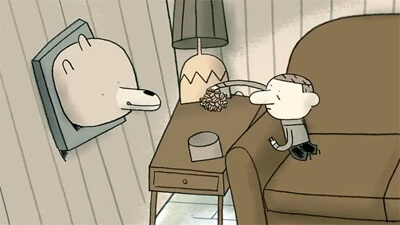
©2011 Patrick Doyon/NFB
When writing a story that has so little dialogue, is it developed as a traditional written script or do you work it out visually (sequential art/storyboarding etc.)?
I like to do quick sketches with some key words to bring to mind the concepts. I’ve always liked working this way… I don’t think I could write a whole scenario using nothing but words.
I often work by brainstorming on an empty sheet. I draw whatever’s going through my head (or thereabouts), let it sit for a while, and later I gather the best ideas and make the storyboard. But it is never definitive… I always leave some room for improvisation. When production takes such a long time, it can quickly become tiring if we don’t allow room for new thoughts. The fact that I work alone or with a small team affords me such liberties.
What do you hope audiences will take from it?
I’m not sure… I mostly hope they’ll spend an enjoyable 10 minutes. I deliberately left the last scene (with the plant and the snow) open to let the viewer make of it what they want. I really like films that stay with you for some time and leave you some space to imagine what happens next.
Would you say that your background in design and illustration has heavily informed your animation style or do you consider them separate?
I’d say yes… Each time I create a shot, a scene, I try to remember some of the concepts I learned in university (composition / textures / impact / clarity).
What sort of opportunities have been made available to you and the NFB subsequent to the Oscar nomination?
I have mostly given interviews and been invited to festivals as a member of the jury (a first for me.) Since I already had prior obligations to honour before the mad rush for the Oscars, I did not do much advertising for new contracts. But of course, an Oscar nomination brings a lot of visibility and it can help when submitting later projects. We’ll see… In any case, for my next film, I will be teaming up with the NFB again: a dream partnership for an animated film creator.
Now that you’ve made a few films do you plan on focusing on animation as your primary career or will you return to illustration?
In an ideal world, I would like to continue alternating between animation and illustrating jobs. They work different parts of the brain and each domain can nourish the other. It’s always nice to do more animation after having worked in illustrating, and vice-versa. Also, in the field of arts, it’s always good to have many strings to one’s bow.
Are there any current/future projects you have that you can tell us about?
Right now, I am working on illustrating my first children’s book. It will be released in spring 2013, published by La Pastèque. I can’t wait to hold the printed book in my hands. The title is “Le Voleur de Sandwichs” (“The Sandwich Thief”) and tells the story of a boy who tries to find out who is stealing the sandwiches so carefully made for him by his mother. The story is by André Marois and it is the kind of project I like as the publishers give me a lot of room to maneuver. Later this year I will start writing a new scenario for another animated short. I already have some images in mind, but it is still too early to talk about it. I would like to explore a few of the themes touched upon in “Dimanche”.
The full short “Dimanche” is available to buy on iTunes and the NFB website, with the official Facebook page at facebook.com/dimanchelefilm. For more on Patrick Doyon visit his website at doiion.com. You can also follow his blog, Twitter, portfolio and Vimeo page.
Interview by Ben Mitchell, translation by Pierre Sylvain and Erica Mitchell.

